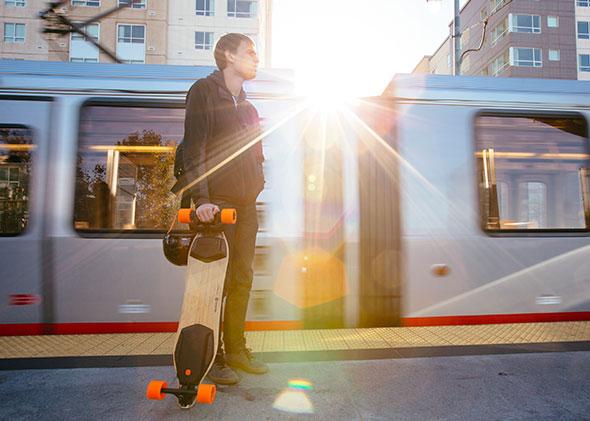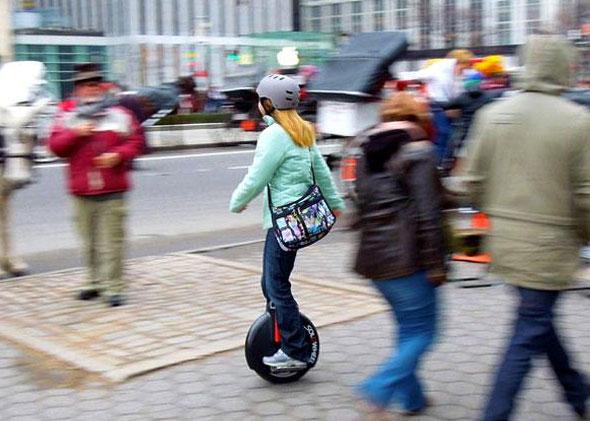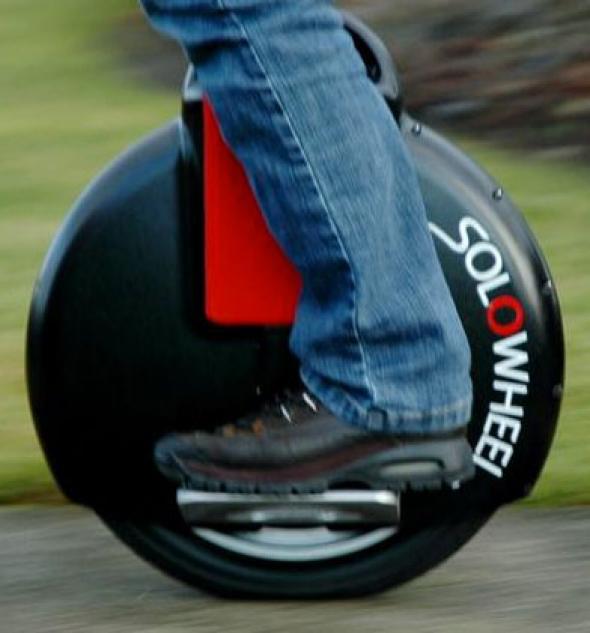For many years, whenever I saw a fully grown adult zinging around a city on one of those stand-up scooters, I’d feel a twinge of contempt. Scooters have always, to me, seemed childish. The purview of 6-year-old kids wearing purple safety helmets. Or perhaps of techie dweebs who kick-glide down the corridors of Silicon Valley corporate campuses—but I confess I tend to imagine those folks possessing the emotional maturity of 6-year-old kids.
What makes a grown-up choose to ride a nonstandard personal conveyance? This embrace of the childlike has always seemed to me less about function and more about projecting an air of “zaniness.” (Or of defiant self-conception: “I’m a unicycle guy! Deal with it!”) The average person thinks to herself: Couldn’t that fellow on the scooter just ride a regular bike? Couldn’t that woman on the Segway just, like, walk? Couldn’t that dude on the unicycle take a look in the mirror and ponder the life choices that led to him riding a unicycle?
And yet: As populations flock back into urban areas, and housing costs drive some of us farther from city centers, a transportation challenge has emerged that just might bring certain sorts of unorthodox personal vehicles into play. Probably not the Segway. (Sorry, Segway.) Or the unicycle. (Not sorry, unicycle.) But there’s a niche out there for, say, the foldable electric scooter. And the time has come to cut adult riders of these goofy vehicles some slack.
Maybe you live a mile and a half from the nearest subway station. Or perhaps you take the light rail to work, but after you hop off the train it’s still a 2-mile walk to your company’s headquarters. Distances like these can require 30 minutes of walking, or more. They add enough time to your commute that you might be tempted to give up on public transport altogether and drive a car or (if you can afford it) spring for an Uber instead.
The particular challenge faced here is called, in transport circles, the last mile problem. How do you cut that half-hour of walking down to an eight-to-10-minute ride using some sort of interim vehicle—a compact conveyance that fills the gap between home or work and the nearest public transportation hub?

Courtesy Brompton Bicycles
One classic solution is the bicycle. But while bikes can be a lovely part of any multimodal commute—breezy, scenic, elegant—they’re not always a perfect choice. For one thing, bikes are large. It’s possible to schlep a bike down into the subway or strap it to the exterior of a bus, but this process is not, as Uber flacks might say, “frictionless.” Storing your own bike can be impractical if you live in a small apartment, and locking a bike outside overnight risks theft. Some cities offer bikeshares—a commuter may dislodge a bike from a dock conveniently located next to a train stop, and then pedal to another dock closer to her end destination—but many cities don’t, and even those that do don’t put docks everywhere you need them. Folding bicycles mitigate some of these problems, but still: Sometimes you don’t want to cycle (or, by the same token, rollerblade) in your nice work clothes, fearing that you’ll gush rivulets of sweat on your way to a client meeting. Maybe you just don’t fancy an exercise session at the end of a long, wearying day, and thus prefer a much lazier means of propulsion.
Whatever the reason, you might find you pine for something powered by a motor but small enough to carry onto a train. Well, lucky for you, there are some compact, motorized, last-mile transport solutions. I tested out a few to see if they might improve my commute without making me feel like a total doofus.
Boosted Dual
$1,299
Maximum speed: 20 mph
Range on one charge: 6 miles
Time to fully charge: 90 minutes (60 minutes for a 90 percent charge)
Motor power: 1,500 watts
Weight: 15 pounds
Doofus factor: Moderate. Skateboards retain some residual punk cool even after you motorize them.

Courtesy Boosted
The Boosted board seems nigh futuristic in its capabilities. It’s a skateboard with a motor teensy enough to fit beneath the board’s deck yet strong enough to zoom you along at 20 mph on flat ground. Lest you doubt this thing’s torque: It can power a 185-pound person up a 20 percent incline.
You operate the board with a wireless remote control wand, smoothly accelerating or decelerating with a subtle nudge of your thumb. At 38 inches long and weighing 15 pounds, the board is small and light enough to strap onto a sturdy backpack, stow under a desk, or tuck between your knees aboard a subway. Until the hoverboard goes mainstream, this is as close as you’re gonna get.
Still, it’s imperfect. Unless you’re already comfy rolling around town on a regular skateboard, don’t expect to feel comfy climbing aboard one that cruises at the speed of a moped. Sharp turns are out of the question unless you’re Tony Hawk. No matter how much I cantilevered my weight side to side, I could achieve nothing more than a slow, gradual arc. More troublingly, there’s nothing to hold onto when you brake hard, so you simply fly forward off the board and hope to hit the ground running—instead of tumbling. One look at the company’s safety FAQ (e.g., “Remember that your board may lose power and brakes at any moment”) suggests that riding this thing may not be for the faint of heart.
Tellingly, most of the videos on Boosted’s site seem to feature experienced boarders on wide-open roads, in no danger of encountering traffic, free to carve long, graceful turns. In this situation—as I found when I brought the board upstairs to a huge, uninhabited floor in Slate’s building and put it through its paces—the board is tremendous fun. If your commute is, say, through the empty roads of a little-trafficked office park, you’ll be thrilled. If you’re attempting to carve serpentine turns in Midtown at rush hour, you might get splatted.
Solowheel Classic
$1,595
Maximum speed: 10 mph
Range on one charge: 10 miles
Time to fully charge: Two hours
Motor power: 1,500 watts
Weight: 25 pounds
Doofus factor: Unimaginably high. Just off the fricking charts.

Courtesy Inventist
The Solowheel springs from the eccentric mind of Shane Chen, the inventor of other quirky personal transport devices such as the Hovertrax (a sort of segmented skateboard) and the Aquaskipper (a sort of … gosh, I’m not really sure … maybe a kayakcycle?). Combining the gyroscopic sensors of a Segway and the inherent absurdity of a unicycle, the Solowheel is, as its name suggests, one single wheel. You stand on platforms that have been bolted to both sides of this wheel. When you lean forward, the wheel’s motor engages and zooms you forward at speeds up to 10 mph.
In videos, you can watch people zipping around on the Solowheel like it ain’t no thang. Just straight chilling, standing on a wheel, rolling down the road. Looked like fun! When I tried it myself, I found it nearly impossible to balance on the Solowheel for more than about three seconds. That gyroscopic balancing mechanism works on the front-to-back axis, but there is no balance-assist offered when you accidentally lean side to side. Despite many, many attempts, I could never advance more than 4 feet before toppling over. In the meantime, the insides of my calves were rubbed raw as I squeezed the Solowheel between them.
I am a relatively coordinated, athletic person. But I wondered if perhaps I was an outlier—the lone weirdo who somehow can’t manage to master the Solowheel. So I asked several Slate colleagues to give it a go. Not one of them was able to stay atop the thing (as you can see in the video we made). Between the roughly 20 of us who tried to ride the Solowheel in a simple straight line without falling off, I think we managed to cover a cumulative 15 feet. And again, there were bruised and abraded legs along the way. Many awkward, involuntary dismounts. No one could imagine getting the hang of this. Certainly not riding it on a busy city street.
When I spoke to Joalene Jolivette, the marketing director at Solowheel’s parent company, Inventist, she acknowledged that there’s a learning curve. “People really struggle at first,” she said. “The average person can’t just step on and go. It’s the same with when you learn a bike, or windsurfing or rollerblading. It takes a while, but once you get it, it’s a piece of cake.” Jolivette suggested that after three or four days of 20- or 30-minute practice sessions, anyone can get the knack for it.
She might be right. But I put in about half that time and could already see it wasn’t worth my while to go any further. Keeping the Solowheel balanced and upright—if I ever managed to do that—seemed akin to the workout I’d get from an intense yoga session. And that’s just to go in a straight line. Steering this device by twisting my weight side to side seems like it would require Olympic-level physical skills. Meanwhile, a folding bike would weigh the same, take up about the same amount of space, never need to be charged, go as fast, and look about one-eighth as dorky. I’m all for exotic inventions, but the Solowheel seems pointless.
EcoReco M3 E-Scooter
$999
Maximum speed: 20 mph
Range on one charge: 20 miles
Time to fully charge: 4.5 hours (2.5 hours to 85 percent)
Motor power: 250 watts
Weight: 34 pounds
Doofus factor: Significant but not debilitating. Requires overcoming some ingrained biases regarding the propriety of scootering as a grown-ass person.

Courtesty EcoReco
I absolutely loved tooling around Manhattan on the EcoReco, a device that’s like a child’s scooter that’s been ’roided up by an electric motor. You stand on it, holding upright handlebars, and kick with your foot to start. It accelerates smoothly and silently as you pull on its throttle trigger. It has a reassuring, bicycle-style brake on its handlebar for when you need to come to a quick stop. I had zero trouble controlling its speed, steering it around corners, or gracefully hopping on and off.
When folded—a process easily accomplished in a few seconds—the EcoReco can be stowed under a desk or in a hall closet. It’s no problem on a moderately populated subway car. In a packed subway, it’s a bit bulkier than you want it to be, but not unmanageable.
I actually looked forward to running errands around the city so I could take this thing out for a spin. People in the office also begged to give it a try. When I lent it out, folks of all shapes and sizes came back from their scooter jaunts with smiles on their faces. Save, that is, for one fellow who forgot to let go of the throttle after his dismount, squeezing the accelerator even though he was no longer on board. The scooter zoomed into a printer, creating much commotion but no lasting damage.
The EcoReco was designed by an electrical engineering Ph.D. named Jay Sung who previously studied photonics and plasma lasers. The scooter’s motor is remarkably quiet, yet it had no problem powering me up an incline. The whole thing feels sturdily built, with an aluminum and stainless steel body and a pair of solid rubber tires that won’t go flat. The tradeoff here is that, at 34 pounds, it was heavier than I wanted it to be when I lugged it down a flight of stairs or through a subway turnstile. Smaller riders in particular might have trouble hefting the scooter in its folded form—though Sung envisions people mostly walking the scooter at their sides during moments when they can’t ride.
The foldable electric scooter is still a relatively new product category, and there aren’t a ton of competitors out there. Sung mentioned Go-Ped as a quality alternative (though he claims the EcoReco’s motor is more efficient and quieter), but I couldn’t get my hands on Go-Ped’s comparable I-Ped2 model, which retails for anywhere from $1,149 up to $2,540 depending on motor and battery options. I did try:
Myway scooter
$1,499.99
Maximum speed: 15-18 mph
Range on one charge: 15–20 miles
Time to fully charge: Four hours
Motor power: 250 watts
Weight: 29 pounds
Doofus factor: Same doofusyness as the EcoReco
The Myway will be distributed in the U.S. as the Jetson Myway and available for sale on Amazon starting sometime in the next few weeks—according to Josh Sultan, CEO of Jetson Electric Bikes. The Myway’s specs are nearly identical to the EcoReco’s. It’s a few pounds lighter but no less awkward a bundle to carry when collapsed.
Instead of the EcoReco’s solid wheels, the Myway’s tires are inflatable, which creates a slightly less jouncy ride but also introduces the hassle of pumping them up and the possibility of a flat. (A different EcoReco model offers inflatable tires as an option.) In general I found the Myway’s motor slightly louder than the EcoReco’s and less smooth to accelerate. Otherwise, this is basically the same product. I’d choose the EcoReco based on price and on my slight preference for its overall design.
But, the overarching question: Would I actually buy and use any foldable electric scooter in real life? I must confess, the experience of bopping around the city on a scooter offered a form of pure, childlike joy, and was practical to boot. I briefly gave serious consideration to integrating an e-scooter into my life. That is, until I learned one crucial piece of information: Motorized scooters are not street-legal in New York.
Before I realized this, I actually scooted right past a cop who saw me and didn’t stop me. Also, I’ll note that electric bicycles are similarly banned, yet at any given moment on a Manhattan street corner you can watch about 400 takeout food delivery guys cruising by on them. Still, laws are laws—though I think we should eventually find some way to issue permits or otherwise allow these things, since I can now attest that e-scooters provide both utility and delight.
If you live in California, or other states where electric scooters are tolerated, I heartily recommend the EcoReco. And if not, may I suggest a nice, superlatively compact, folding Helix bike?
Update, Nov. 28, 2016: This video has been removed pending the resolution of a licensing claim.
